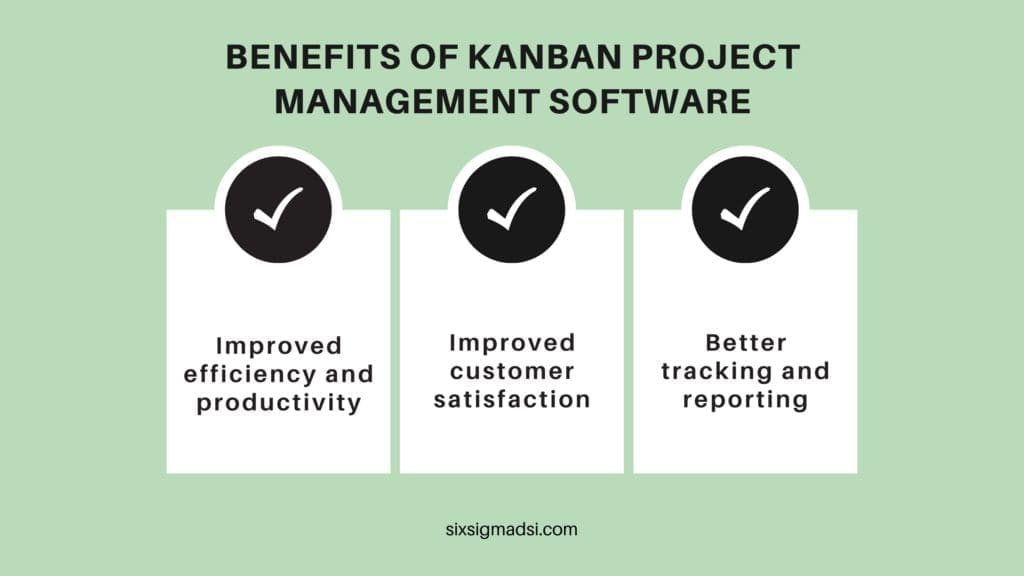Table of contents
Kanban Project Management Software
A Kanban project management software is a tool that allows teams to manage and visualize their work using the Kanban method. It provides teams with a visual representation of the workflow, and it allows them to manage and prioritize tasks, identify bottlenecks, and improve efficiency and productivity.
Kanban project management software typically includes features such as:
- A Kanban board that displays tasks and issues as cards, and allows teams to move them through various stages of processing.
- Work-in-progress (WIP) limits help teams to limit the number of tasks that are in progress at any given time.
- Prioritization tools allow teams to prioritize tasks based on their importance and urgency.
- Reporting and analytics tools that help teams to measure performance and identify areas for improvement.
- Integration with other tools and systems, such as source control, continuous integration, and test automation.
Some examples of Kanban project management software include Jira, Trello, Asana, Kanbanize, and Targetprocess. These tools are designed to suit different needs and can be used by different teams and organizations. It’s important for teams to evaluate their specific needs and goals before choosing Kanban project management software.
What is Kanban?
Kanban is a method of managing and visualizing work as it moves through a process. It is focused on visualizing and limiting work in progress, and it is commonly used in manufacturing and service industries. It was originally developed by Taiichi Ohno as a method for improving efficiency at Toyota manufacturing plants in the 1940s. The term “Kanban” is Japanese for “signboard” or “billboard.”
In software development, Kanban boards are used to visualize the flow of work, identify bottlenecks, and optimize flow. Tasks and issues are represented as cards on the board and moved through various stages of processing, such as “to do,” “in progress,” and “done.” The number of tasks or issues that can be in progress at any given time is limited, usually by a set number of “work in progress” (WIP) limits. This helps to ensure that teams are not overburdened with too much work and that tasks are completed in a timely manner.
Kanban can be used in conjunction with other methodologies such as Scrum, or it can be used as a standalone method. It is often used in software development, IT, marketing, and other service industries, but it can be adapted for use in any process or industry.
Benefits of using a Kanban Project Management Software

There are several benefits of using Kanban project management software, including:
- Improved visualization of the workflow: It provides a visual representation of the workflow, making it easy to see the progress and status of tasks. This can help teams to better understand where they are in the process and what they need to do next.
- Increased flexibility and adaptability: It allows for flexible and adaptive planning, as tasks can be easily moved and reprioritized. This can be especially beneficial for teams that are working in an unpredictable or rapidly changing environment.
- Improved efficiency and productivity: It allows focus on a “pull” system, where work is pulled through the process only when there is capacity, can help teams to limit work in progress and prioritize their efforts, which leads to improved efficiency and productivity.
- Better team collaboration: Kanban project management software can be used to facilitate collaboration and communication within teams, as all members have a clear understanding of the workflow and the progress of tasks.
- Reduced lead time: By limiting work in progress, Kanban project management software helps teams to focus on completing one task at a time which can lead to a reduction in lead time.
- Improved customer satisfaction: Kanban project management software allows for continuous integration and delivery of new features, which can help teams to deliver software faster and more frequently, which can lead to better customer satisfaction.
- Better ability to manage change: It is an adaptive method and allows teams to respond to change in a more flexible way.
- Better metrics to measure performance: A Kanban project management software provides metrics like lead time, cycle time, WIP, etc which can be used to measure performance and optimize the process.
- Better tracking and reporting: It provides the ability to track and report on various aspects of the work, like the time spent on tasks, the number of completed tasks, and more.
Overall, using Kanban project management software can provide teams with improved visibility, flexibility, and efficiency, leading to better collaboration, faster delivery, and better customer satisfaction. Additionally, it can provide better tracking and reporting capabilities to improve the overall performance of the project.
Examples of using a Kanban Project Management Software
Here are a few examples of how Kanban project management software can be used:
- Software development: Teams can use Kanban project management software to manage the flow of tasks and issues from development to testing to deployment. They can visualize the progress of tasks and issues and identify bottlenecks in the workflow.
- IT operations: IT teams can use them to manage and prioritize incidents and service requests and to track the progress of tasks related to incident resolution and service delivery.
- Marketing: Marketing teams can use them to manage and prioritize tasks related to campaigns, content creation, and event planning. They can track the progress of tasks and identify bottlenecks in the workflow.
- Human Resources: HR teams can use Kanban project management software to manage the recruitment process, onboarding process, and other HR-related tasks. They can prioritize tasks and track the progress of the recruitment process.
- Support teams: Support teams can use them to manage and prioritize customer service requests, and to track the progress of tasks related to incident resolution and service delivery.
- Project Management: Project managers can use them to manage and prioritize tasks related to a project, track progress and identify bottlenecks in the workflow.
Overall, Kanban project management software can be used in many different ways, and it is a flexible tool that can be adapted to suit the specific needs of different teams and organizations.

Importance of using Kanban Project Management Software
Kanban is an important tool in project management because it helps teams to visualize and manage the flow of work, prioritize tasks, and improve efficiency and productivity.
In project management, Kanban can be used to manage the flow of tasks and issues from planning to execution to closure. It can help teams to identify and address bottlenecks in the workflow, and it allows for flexible and adaptive planning, as tasks can be easily moved and reprioritized.
Kanban boards provide a visual representation of the workflow, making it easy to see the progress and status of tasks, which helps team members to better understand where they are in the process and what they need to do next. Additionally, the focus on a “pull” system, where work is pulled through the process only when there is capacity, can help teams to limit work in progress and prioritize their efforts, which leads to improved efficiency and productivity.
Kanban also allows for continuous integration and delivery of new features, which can help teams to deliver software faster and more frequently, which can be especially beneficial for teams that are focused on delivering software as a service.
Overall, Kanban is an important tool for project management teams because it helps them to visualize and manage the flow of work, prioritize tasks, and improve efficiency and productivity, which leads to better delivery of projects and better customer satisfaction.
Have you used a Kanban Project Management Software? What benefits have you noticed?
Let us know in the comments.



















